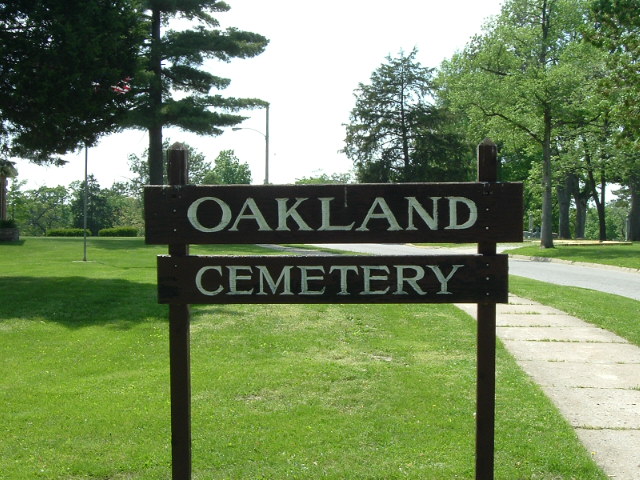
Oakland Cemetery
Keokuk, Lee County, Iowa, USA
Until 1837, the sole inhabitants of the area that is now the town of Keokuk, Iowa, were members of the Sauk and Fox tribes. In 1837, however, the tribes agreed to a treaty that allowed limited settlement of white farmers. Shortly after the treaty went into effect, white settlers began to migrate into the area. But the greatest number of settlers did not arrive until 1842 when a second treaty compelled the Fox and Sauk to move farther west. The treaty would go into effect in May 1842, although white settlers had begun camping along the county border a month earlier. Subsequently, at one minute after midnight on May 1, anxious settlers rushed in to stake their land claims.
By the beginning of the Civil War, Keokuk was home to a population of approximately 13,000 people. Its location, at the confluence of the Des Moines and Mississippi rivers, made an ideal location for the transportation of produce for the war. The first Civil War facility in Iowa was Camp Ellsworth, located near Keokuk, where troops were mustered as early as May 1861. More posts, including Camps Rankin, Halleck and Lincoln were established in 1861 and 1862. As the war progressed, five Army hospitals were established in the area to help care for the thousands of sick and wounded soldiers transported up the Mississippi River from Southern battlefields. Most of the original interments at Keokuk National Cemetery came from these hospitals.
The 2.75-acre Keokuk National Cemetery was originally a part of Oakland Cemetery until the city donated the land to the U.S. government in the mid 19th-century. According to an 1871 inspection report, just after the Civil War there were 627 interments; 600 known Union soldiers and 27 unknown soldiers. Not mentioned in the report were the remains of eight Confederate soldiers buried at the national cemetery, who died in Keokuk as prisoners of war.
In 1908, when the frontier post of Fort Yates, N.D., was abandoned, the remains buried at this post cemetery were reinterred at Keokuk. Similarly, in 1948, 156 bodies removed from the post cemetery at Des Moines, Iowa, were reinterred here.
Keokuk National Cemetery was placed on the National Register of Historic Places in 1997.
(Ref: Keokuk National Cemetery and city
Until 1837, the sole inhabitants of the area that is now the town of Keokuk, Iowa, were members of the Sauk and Fox tribes. In 1837, however, the tribes agreed to a treaty that allowed limited settlement of white farmers. Shortly after the treaty went into effect, white settlers began to migrate into the area. But the greatest number of settlers did not arrive until 1842 when a second treaty compelled the Fox and Sauk to move farther west. The treaty would go into effect in May 1842, although white settlers had begun camping along the county border a month earlier. Subsequently, at one minute after midnight on May 1, anxious settlers rushed in to stake their land claims.
By the beginning of the Civil War, Keokuk was home to a population of approximately 13,000 people. Its location, at the confluence of the Des Moines and Mississippi rivers, made an ideal location for the transportation of produce for the war. The first Civil War facility in Iowa was Camp Ellsworth, located near Keokuk, where troops were mustered as early as May 1861. More posts, including Camps Rankin, Halleck and Lincoln were established in 1861 and 1862. As the war progressed, five Army hospitals were established in the area to help care for the thousands of sick and wounded soldiers transported up the Mississippi River from Southern battlefields. Most of the original interments at Keokuk National Cemetery came from these hospitals.
The 2.75-acre Keokuk National Cemetery was originally a part of Oakland Cemetery until the city donated the land to the U.S. government in the mid 19th-century. According to an 1871 inspection report, just after the Civil War there were 627 interments; 600 known Union soldiers and 27 unknown soldiers. Not mentioned in the report were the remains of eight Confederate soldiers buried at the national cemetery, who died in Keokuk as prisoners of war.
In 1908, when the frontier post of Fort Yates, N.D., was abandoned, the remains buried at this post cemetery were reinterred at Keokuk. Similarly, in 1948, 156 bodies removed from the post cemetery at Des Moines, Iowa, were reinterred here.
Keokuk National Cemetery was placed on the National Register of Historic Places in 1997.
(Ref: Keokuk National Cemetery and city
Nearby cemeteries
Keokuk, Lee County, Iowa, USA
- Total memorials6k+
- Percent photographed97%
- Percent with GPS19%
Keokuk, Lee County, Iowa, USA
- Total memorials2
- Percent photographed0%
- Percent with GPS0%
Keokuk, Lee County, Iowa, USA
- Total memorials5
- Percent photographed0%
- Percent with GPS0%
- Added: 1 Jan 2000
- Find a Grave Cemetery ID: 95674
Success
Uploading...
Waiting...
Failed
This photo was not uploaded because this cemetery already has 20 photos
This photo was not uploaded because you have already uploaded 5 photos to this cemetery
This photo was not uploaded because you have already uploaded 5 photos to this cemetery
Invalid File Type
Birth and death years unknown.
1 photo picked...
2 photos picked...
Uploading 1 Photo
Uploading 2 Photos
1 Photo Uploaded
2 Photos Uploaded
Size exceeded
Too many photos have been uploaded
"Unsupported file type"
• ##count## of 0 memorials with GPS displayed. Double click on map to view more.No cemeteries found











